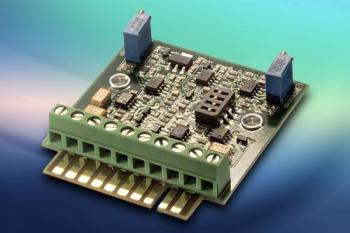Jun 5 2014
Measurement Specialties, an expert in sensor design and manufacturing, has developed a compact OEM signal conditioning transmitter designed for high performance across a wide temperature range of -25 degrees C to +85 degrees C.
 Measurement Specialties’ High-performance OEM LVDT/RVDT signal transmitter for industrial applications (PRNewsFoto/Measurement Specialties, Inc.)
Measurement Specialties’ High-performance OEM LVDT/RVDT signal transmitter for industrial applications (PRNewsFoto/Measurement Specialties, Inc.)
The new LiM-420 operates on an 18 VDC to 30 VDC unipolar supply voltage and delivers a low noise 4 mA to 20 mA current output signal.
The new transmitter is compatible with many LVDT or RVDT transducers with five and six electrical connections and even with low input impedance. This makes the LiM-420 ideal for many general industrial applications such as valve position feedback, roller gap sensing, material testing machines and many others.
An easily-accessed DIP switch enables six selectable gain ranges while two 20-turn potentiometers allow for fine zero and gain adjustments for exact calibration.
The generous excitation drive current of 20 mA enables the board to operate with transducer impedances as low as 175 Ohms. Non-linearity is +/-0.05% of Full Scale Output and stability is also +/-0.05% of FSO after a 30-minute warm up. The board features a maximum supply current of 50 mA and a maximum loop resistance of 500 Ohms (with a 24 VDC supply). The maximum output noise and ripple is only 25 micro Amps RMS.
The LiM-420 can be either plugged directly into a backplane-style connector using the built-in card-edge guides or wired to the screw terminal barrier strip. The board can be mounted or stacked using the permanently-attached threaded standoffs or the card-edge guides.
Technical Specifications:
- Current output, LVDT/RVDT OEM signal transmitter
- High operating temperature: -20 degrees C to +85 degrees C
- 18 VDC to 30 VDC unipolar supply voltage
- Output noise and ripple: 25 micro Amps RMS maximum
- Frequency response: 50 Hz at -3 dB
- Six selectable gain ranges
- Two multi-turn zero and gain adjustment potentiometers